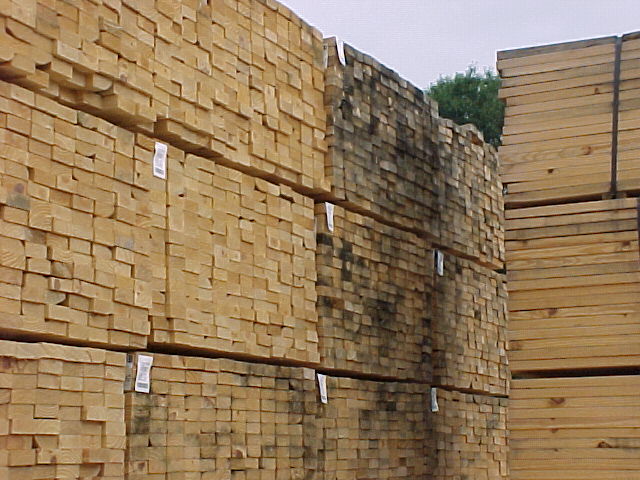Mold and Moisture
Mold and Moisture:
How to prevent
And Treat it
Mold and moisture management are key to protecting your Southern Pine lumber, and it’s not a difficult process as long as you follow a few key guidelines.
Mold is a simple microscopic organism, present virtually everywhere – even Southern Pine. It grows naturally in an outdoor environment, but spores can enter a house through open doorways, windows, heating, ventilation, and air conditioning systems. Once indoors, it often finds conditions suitable for growth.
Mold requires moisture, oxygen, nutrients, and a temperature between 40°F and 100°F to grow. Therefore, it will grow almost anywhere under normal conditions. Mold can thrive using moisture from virtually any source, ranging from condensation on windows to roof leaks.
Food sources for mold include a long list of common household materials, including, but not limited to:
- Cardboard
- Carpet
- Ceiling tiles
- Drywall
- Fabrics
- Insulation
- Paint
- Paper
- Wallpaper
- Wood products
Although poor construction and maintenance practices can create conditions that exacerbate mold growth, the presence of mold in today’s homes has not necessarily increased. The good news is, discoloration aside, mold generally has little effect on the structural integrity of framing lumber.
Protecting wood products from moisture is key to preventing mold growth.
Properly dried lumber (MC 19% or less) and most engineered wood products do not contain enough water to support mold growth. However, all wood products, including lumber, plywood, oriented strand board, glulam beams, and I-joists are equally vulnerable to mold growth if not protected from moisture during transportation, storage, and construction.
mold and moisture management tips
- Paper Wrap: Manufacturers typically offer buyers the option to wrap units (lumber on five sides) or individual pieces (glulam beams on all six sides) with special paper for additional protection during shipment and storage. Although effective, paper wrap can be damaged during transit or storage, so it should not be the only step taken to protect wood products stored in a lumberyard or at a job site.
- Proper Shipping: Most wood products are shipped from the manufacturer on open rail cars or flatbed trucks. Paper wrapping can increase mold and moisture protection; covering units loaded on flatbed trucks with a full tarpaulin will also increase the level of protection.
- Job Site Storage: Inspect all wood products immediately upon delivery. Units need to be properly supported at least four inches off the ground and protected with a tarpaulin or other vapor-permeable cover. Effective mold and moisture management calls for jobsite storage time to be minimized and the structure enclosed as soon as possible.
- Verify an Industry-certified Grade Mark: Stamped on every piece of material, this mark ensures the manufacturer graded the material in compliance with the appropriate product standards. For example, look for Southern Pine grademarks that include “KD19,” indicating the material has been kiln-dried to a moisture content of 19% or less.
- Confirm the Moisture Content: Use a moisture meter if questions arise concerning the material’s delivered moisture content. Once the builder has verified all framing material delivered to the site has a moisture content of 19% or less, the material should be used as quickly as possible.
- Practice Good Housekeeping: Segregate scraps from the lumber storage area. Scraps scattered on the ground provide food for mold. If mold is found on wood products during construction, clean the material and allow it to dry before using it within the structure.
What to Do If There’s Water Damage
In a remodeling or flood recovery situation, clean any mold found on or in an existing structure, then identify and correct any moisture sources. Allow all framing material to thoroughly dry below 19% moisture content before enclosure.
Ventilation is the key to proper drying, so keep doors and windows open and use fans when possible to accelerate moisture removal.
How to Clean Mold
While it won’t prevent future mold growth (only changing the environmental conditions noted above can do that), you can create a detergent and water solution or a 10% bleach-to-water solution (1 1/2 cups bleach per 1 gallon of water), and scrub the surface using the recommended solution and a bristle brush or scrub sponge. Rinse the brush/sponge frequently, and thoroughly dry the wood after cleaning.
Large mold colonies should be addressed by an experienced professional. High-efficiency particulate air (HEPA) vacuuming after cleaning may also help remove any remaining mold spores.
Warning: Do not mix bleach with ammonia or any other detergents or cleaners that contain ammonia. Bleach mixed with ammonia forms a lethal combination similar to mustard gas. Many household cleaners contain ammonia, so be careful when selecting the type of cleaner to mix with bleach.

Click here to review a Mold and Moisture one-pager to properly prevent and treat mold- and moisture-related issues.